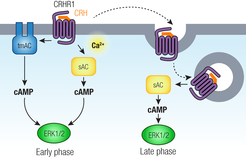New signaling mechanism of the corticotropin-releasing hormone type 1 receptor
Collaboration between Instituto de Biomedicina de Buenos Aires - CONICET - Partner Institute of the Max Planck Society and the Max Planck Institute of Psychiatry

Dysfunction of the corticotropin releasing hormone (CRH) and its receptor (CRHR1) system in limbic structures has been implicated in the pathogenesis and course of psychiatric disorders including depression and anxiety. A recent publication in the Journal of Cell Biology by Susana Silberstein of Instituto de Biomedicina de Buenos Aires - CONICET - Partner Institute of the Max Planck Society (IBioBA-MPSP) and Chris Turck and Giuseppina Maccarrone of the Max Planck Institute of Psychiatry describes new molecular mechanisms and cellular components involved in CRHR1 signaling. The information is critical for a better understanding of CRH physiological function in the central nervous system. The study used proteomic data generated by Giuseppina Maccarrone and Chris Turck at the Max Planck Institute of Psychiatry to generate hypotheses that were subsequently tested with sensitive single-cell optical methods by Susana Silberstein’s group at IBioBA-MPSP to assess the spatiotemporal dynamics of CRH-dependent cellular response. The results of the study show that a second atypical source of cyclic AMP exists that is generated by soluble adenylyl cyclase (sAC) in response to CRHR1 activation. In hippocampal neuronal cells cAMP was found to activate specific signaling pathways that are dependent on the origin (transmembrane or soluble adenylyl cyclases) and cellular location (cell surface or endosomes) of cAMP generation. These findings stress the importance of spatial and temporal restrictions during cellular signaling that lead to specific cellular responses to stimuli. Similar mechanisms are expected to mediate the action of other signaling systems implicated in pathophysiology. Future work will include a systematic analysis of sAC interactions to provide insight into specific functions of spatially restricted cAMP pools in cellular responses. Understanding the role of cell surface and endosome-dependent signaling along with the identification of functionally selective ligands may result in clinical tools for pathologies involving the CRH/CRHR1 system.
The work is a showcase of the very successful interactions and joint research efforts between the Instituto de Biomedicina de Buenos Aires - CONICET - Partner Institute of the Max Planck Society and the Max Planck Institute of Psychiatry. Eduardo Arzt, Director of IBioBA and external scientific member of the Max Planck Institute of Psychiatry, comments: “This joint publication is the result of our concept of complementary approaches between our Institutes. It opens new avenues of research not only in the CRH but also in the cAMP-coupled receptor fields”.
The project “Cellular mechanism and molecular components of CRH signaling in the central nervous system” is part of an ongoing collaboration between the research groups of Dr. Susana Silberstein (Molecular mechanisms of CRH receptors signaling) at IBioBA, Argentina, and Dr. Chris Turck (Proteomics and Biomarkers) at the Max Planck Institute of Psychiatry. The study received financial support from joint grants of Agencia Nacional de Promoción Científica y Tecnológica (ANPCyT-Argentina) and Max Planck Society (PICT MP2010:2791 and PICT MP2013:0392).
SS/CT
